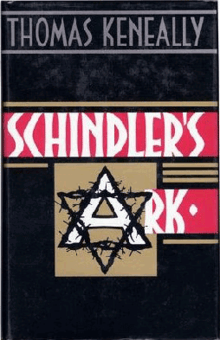Schindler's Ark
Schindler's Ark is a Booker Prize-winning historical fiction novel published in 1982 by Australian novelist Thomas Keneally. The United States edition of the book was titled Schindler's List; it was later reissued in Commonwealth countries under that name as well. The novel was also awarded the Los Angeles Times Book Prize for Fiction in 1983.[1]
 First edition cover | |
| Author | Thomas Keneally |
|---|---|
| Country | Australia |
| Language | English |
| Genre | Biographical novel |
| Publisher | Hodder and Stoughton |
Publication date | 18 October 1982 |
| Media type | Print (Hardcover and Paperback) |
| Pages | 380 pp (hardcover edition) |
| ISBN | 0-340-27838-2 (hardcover edition) |
| OCLC | 8994901 |
The book tells the story of Oskar Schindler, a member of the Nazi Party who becomes an unlikely hero by saving the lives of 1,100 Polish Jews during the Holocaust. It is a non-fiction novel which describes actual people and places, with fictional events, dialogue and scenes added by the author, and reconstructed dialogue where exact details are unknown.[2] Keneally wrote a number of well-received novels before and after Schindler's Ark; however, in the wake of its highly successful 1993 film adaptation directed by director Steven Spielberg, it has since gone on to become his most well-known and celebrated work.[3]
Background
Poldek Pfefferberg, a Holocaust survivor and Schindlerjude [4], inspired Keneally to write Schindler's Ark. After the war, Pfefferberg had tried on a number of occasions to interest the screenwriters and filmmakers he met through his business in making a film based on the story of Schindler and his efforts to save Polish Jews from the Nazis, as well as arranging several interviews with Schindler for American television.
Keneally's meetings with Pfefferberg, research and interviews of Schindler's acquaintances are detailed in his 2007 book, Searching for Schindler: A Memoir. In October 1980, Keneally went into Pfefferberg's shop in Beverly Hills to ask about the price of briefcases. Learning that Keneally was a novelist, Pfefferberg showed him his extensive files on Schindler, kept in two cabinets in his back room.[5] After 50 minutes of entreaties, Pfefferberg was able to convince Keneally to write the book. Pfefferberg became an advisor, accompanying Keneally to Poland, where they visited Kraków and other sites associated with the Schindler story. Keneally dedicated Schindler's Ark to Pfefferberg: "who by zeal and persistence caused this book to be written."
After the publication of Schindler's Ark in 1982, Pfefferberg worked to persuade Steven Spielberg to film Keneally's book, using his acquaintance with Spielberg's mother to gain access.
A carbon copy of Schindler's original 13-page list, initially thought to be lost, was discovered in 2009 in a library in Sydney, Australia.[6]
Plot summary
This novel tells the story of Oskar Schindler, self-made entrepreneur and bon viveur who almost by default found himself saving Polish Jews from the Nazi death machine. Based on numerous eyewitness accounts, Keneally's story is unbearably moving but never melodramatic, a testament to the almost unimaginable horrors of Hitler's attempts to make Europe judenfrei (free of Jews). What distinguishes Schindler in Keneally's version is not, superficially, kindness or idealism, but a certain gusto. He was a flawed hero; he was not "without sin". He was a drinker, a womaniser and, at first, a profiteer. After the war, he was commemorated as Righteous Among the Nations by the Yad Vashem Holocaust Museum in Jerusalem, but was never seen as a conventionally virtuous character.[7] The story is not only Schindler's, it is the story of Kraków's Ghetto and the forced labour camp outside town, Płaszów. It is the story of Amon Göth, Płaszów's commandant.[8]
His wife Emilie Schindler later remarked in a German TV interview that Schindler did nothing remarkable before the war and nothing after it. "He was fortunate therefore that in the short fierce era between 1939 and 1945 he had met people who had summoned forth his deeper talents." After the war, his business ventures failed and he separated from his wife. Then he ended up living a shabby life in a small flat in Frankfurt. Eventually he arranged to live part of the year in Israel, supported by his Jewish friends, and part of the year as a sort of internal émigré in Frankfurt, where he was often hissed at in the streets as a traitor to his "race". After 29 unexceptional postwar years he died in 1974. He was buried in Jerusalem as he wished with the help of his old friend Pfefferberg.
References
- "Book Prizes – Los Angeles Times Festival of Books» Winners By Award". latimes.com. Archived from the original on 5 April 2013.
- Shepard, Richard F. "NONFICTION 'SCHINDLER'S LIST' AND A FICTION PRIZE".
- Alfred Hickling. "Review: The Tyrant's Novel by Thomas Keneally". the Guardian.
- HON. TOM LANTOS, in the House of Representatives. 21 April, 1994 Library of Congress. Retrieved 8 September 2006.
- Thomas Keneally. "Schindler's Ark: genesis". the Guardian.
- Marks, Kathy (7 April 2009). "Schindler's lost list found in Australia". The Independent. Sydney: Independent News & Media. Retrieved 7 April 2009.
- Archived 18 May 2008 at the Wayback Machine
- Zweig, Paul. "A GOOD MAN IN A BAD TIME".